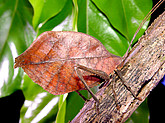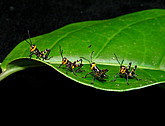Research Projects
FWF-Project P 20882-B09 Competition for call frequencies and the evolution of sensory and behavioral adaptations in a tropical cricket community.
This study combined field and laboratory investigations on the ecology, acoustic behavior and sensory physiology of neotropical crickets in Panama. Most crickets achieve pair formation by acoustic signaling and phonotactic approach. Due to call frequency overlap and masking interference, the air-borne sound channel represents a limited resource for communication in a species-rich cricket community. The overall aim of this study was to describe behavioral, sensory and central nervous adaptations which allow acoustic communication and mate localization despite strong competition for call frequency. Two behavioral adaptations which might contribute to acoustic niche segregation are temporal and spatial separation of species. We expected a reduction of niche overlap or an expansion of niche space for the more species-rich community in Panama compared to temperate habitats described for European field crickets. A quantitative calculation of channel breadths and overlaps along these dimensions will allow us to determine their respective contribution to reproductive isolation.
FWF-Project I 1054-B25 Decision making in crickets
Evidence based on experiments on decision making in humans suggests that the magnitude of human preferences and our rank ordering of options can vary with the number and type of alternatives. It has been argued that the underlying decision heuristics have evolved to enable quick and efficient choices between options differing in several attributes. This problem is particularly relevant under conditions where the various attributes are not positively correlated, so that no single option emerges as superior. Many studies suggest that our choices are irrational, frequently displaying violations of transitivity and independence from irrelevant alternatives. This would suggest that a property is evaluated relative to all other properties available at the time the choice is being made.
The same selection pressure is true for animals when making e.g. mating decisions, and since different mates may also differ in multiple attributes, the same decision heuristics as found in humans might have evolved. In the meantime, decision analysis in biology, computer science, political science, economics and psychology has provided valuable insights into which factors are taken into account to form decisions. However, except from some studies on monkeys, the neural computations that underlie such decisions in other animals are largely unknown. We therefore aim to explore this in a model system of mate choice in field crickets, where we simulate increasingly complex situations for female decision making. Female mate choice will be tested in three “environments” (trackball, arena, and in the field), and the underlying neural mechanism will be studied under the same conditions using identified interneurons.
FWF-Project P 26072-B25 The evolution of directional hearing in crickets
Sound localization in small insects can be challenging due to imposed physical constraints in deriving sufficiently large intensity differences between both ears (IIDs). In crickets, sound source localization is based on a complicated biophysical mechanism using a modified tracheal system connecting the tympana of both ears with an external sound entrance. These acoustic trachea form the basis of a pressure difference receiver; it responds to the interaction of three different sound components at the site of the tympanum, with the result of a directionality of the ear despite an unfavorable relationship between the wavelength of sound and body size.
In a previous survey on different cricket species predominantly of the tropical rainforest, we found large morphological differences of the acoustic tracheal apparatus subserving directionality. What are the factors, the biophysical and environmental constraints accounting for these differences, and how did the pressure difference receiver in crickets evolve at all? What have been the evolutionary precursors of the system, and what are the modifications which provide highest directionality of the system? The current proposal aims to investigate its evolution using anatomical, neurophysiological, biophysical and modelling approaches. We will compare anatomical variation in the acoustic tracheal system of primary non-hearing species with those using elaborate acoustic signalling, and species with secondary loss of sound communication.
FWF-Project P 27145-B25 The “hot male hypothesis”: males communicate their quality by body temperature, a new modality for communication.
Insects have been used extensively as model systems to study mating preferences based on variation in acoustic signals. In many species, females perform phonotactic approaches towards attractive, long range signals of males, and a decision for final mating may be based on further assessment of close range cues. Sound production by males is costly, since only a fraction of muscle energy used to produce the sound is converted into acoustic power. In some katydid and cricket species with long-lasting signalling the male thorax housing the singing muscles increases in temperature by up to 10°C after several minutes of singing. Hence, male body temperature could serve an additional cue during mate choice. This would turn the acoustic signal into an inherently bimodal one, where the energy invested in sound production is not “wasted” but reflected in the elevated thorax temperature of a male, which can be evaluated by females via thermo-sensitive receptor cells located in the long antennae. Preliminary data suggest that these cells respond with high sensitivity to changes in temperature via convective and radiant heat. Since the thorax temperature remains elevated for several minutes even after the male stopped singing, females may evaluate the sound signal indirectly, even if it cannot be perceived by the auditory system.
FWF-Project P 23896-B24 Sensory ecology of detecting predators and conspecifics in masking noise.
Here we combine field and laboratory studies on the ecology, acoustic behaviour and sensory physiology of bat avoidance in tropical crickets and katydids in Panama. Most species of both groups of insect use air-borne sound for communication between the sexes, but also show some kind of bat-avoidance behaviour during flight. The mechanism to distinguish “good” from “bad”, however, is different. Crickets show categorical perception and respond to any stimulus above 15 kHz with avoidance, and positive steering towards stimuli below 10 kHz during flight. By contrast, katydids cannot use frequency as a cue for discrimination, since their own mating signals use the high frequency channel as well.
However, the nocturnal tropical rainforest with its strong high-frequency background noise imposes a problem for bat avoidance, and detecting conspecifics. In this context, the second important difference between the hearing system of crickets and katydids is their sensitivity to ultrasound. Broadly tuned sensitivity of katydids with hearing thresholds between 20 to 40 dB SPL have been reported, whereas the few known thresholds of crickets in the same frequency range are around 60 dB SPL or higher. In the sensory arms race between predator and prey, the higher sensitivity produces an advantage for katydids because it increases the detection range for echolocation calls, giving katydids more degrees of freedom to evolve anti-bat behaviours compared to crickets. However, there is a trade-off between increased sensitivity of a sensory system and the potential for masking by noise. Thus, there is the potential of confounding conspecific calls with bat predators (“false alarms”). The overall aim of this study is to describe and compare behavioural, sensory and central nervous adaptations which allow reliable detection of conspecifics and bats and subsequent adaptive behaviour within noisy rainforest habitats.





